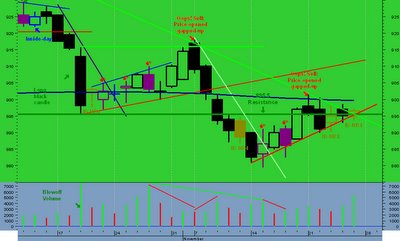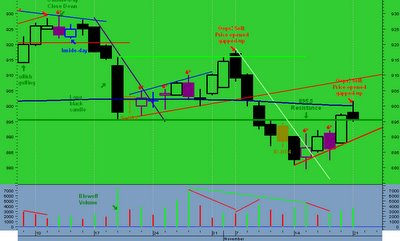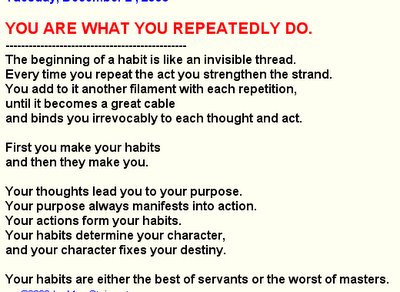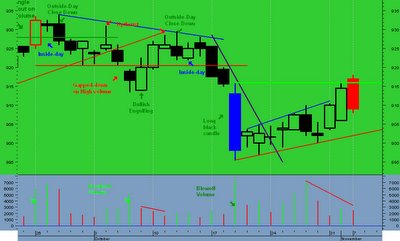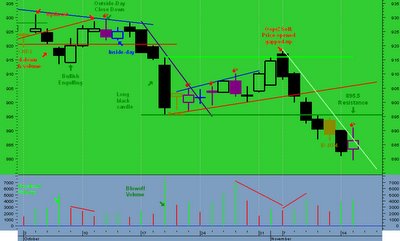FKLI Dec 05 Trades – Nov 28, 2005 - Closed with a net gain of RM175
FKLI Nov 05 Chart as at Nov 25 05
November 28, 2005
1. Entry Strategy for Buy stop order
a. Option 1: The price opens higher than 888
i. Do nothing
ii. If the price near MOC is a whiplash, do nothing.
iii. If the price near MOC is higher the open, buy at MOC with risk <>
b. Option 2: The price opens lower than or equal to 888.
i. Put a buy stop order at 888.5 after FKLI opens for the whole day.
ii. If the order is triggered, put a sell stop order at 885.
iii. If the price closes down below the entry price, cover your long.
c. Option 3 If the market does not appear what you expect, do not trade and stay side-lined to analyze.
2. Entry Strategy for Sell stop order
a. Option 1: The price opens lower than 885
i. Do nothing
ii. If the price near MOC is a whiplash, do nothing.
iii. If the price near MOC is lower than the open, sell at MOC with risk <>
b. Option 2: The price opens higher than 885
i. Put a sell stop order at 885 after FKLI opens for the whole day.
ii. If the order is triggered, put a buy stop order at 888.5
iii. If the price closes above your entry price, cover your short.
c. Option 3: If the market does not appear what you expect, do not trade and stay side-lined to analyze.
3. Pyramiding and Re-entry Strategy
a. No Pyramiding and Re-entry Strategy
4. Trailing Stop
a. The protective stop cannot increase your risk (loss) and reduce your profit unless No 6 and 7 below.
b. The protective stop cannot give back more than 6 points of unrealized profit.
c. When the trade is profitable, move your protective stop to the breakeven point. Trail your stop.
d. Short Position: Move your stop to 1 tick above the open or high, whichever is lower, for sell stop but must be lower than your previous stop. Long Position: Move your stop to 1 tick below the open or low, whichever is higher, for buy stop but must be higher than your previous stop.
e. If the price moves in your favor, the trade is profitable and the prior day bar is a long bar (more than 8 points), move your stop 1 tick above or below the middle of the bar.
f. Short Position: If prior-day's bar is a long bar (8 points or more) and the today's open is higher than prior day's close but below the middle range of prior-day's range, put your stop at 1 tick above the middle of prior-day's range. Long Position: If prior-day's bar is a long bar (8 points or more) and the today's open is lower than prior day's close but above the middle of prior-day's range, put your stop 1 tick below the middle of prior day's range.
g. Short Position: If prior day bar is a long bar (8 points or more) and the today's open is lower than prior day's low, put your stop at 1 tick above the prior day's low. Long Position: If prior day bar is a long bar (8 points or more) and the today's open is higher than prior day's high, put your stop 1 tick below the prior day's high.
h. Short Position: If prior-day's bar is a long bar (8 points or more) and the today's open is higher than both prior day's close and middle range of prior-day's range, put your stop at 1 tick above the prior-day's high. Long Position: If prior-day's bar is a long bar (8 points or more) and the today's open is lower than both prior day's close and middle of prior-day's range, put your stop 1 tick below the prior day's low.
i. The maximum loss is 10 points or high/low of the next bar if the price gaps
5. Exit Strategy for Buy Stop Order
a. If the price does not move up above your entry price and the trade is not stopped out for 3 trading days, get out at MOC on the third day.
b. Let the trailing buy stop follow the price until it is taken out.
6. Exit Strategy for Sell Stop Order
a. If the price does not move up below your entry price and the trade is not stopped out for 3 trading days, get out at MOC on the third day.
b. Move stop order to breakeven point if the price moves in your favor.
c. Use trailing stop based on the chart’s support and resistance for trade management.
d. Get out of the trade when the price hit extreme and get in at different direction if the price gaps.
7. Today’s Entry strategy and Trade Management:
a. Call Apex at 8:45am to check the open. Both spot and next month contract should act the same. Then I will put in buy and sell stop orders.
b. If either order is triggered, ask Apex to call you.
c. Move stop order to breakeven point if the price moves in your favor.
d. Use trailing stop based on the chart’s support and resistance for trade management.
e. If the price closes lower than the entry price for buy stop order, close the position at MOC. If the price closes higher than the entry price for sell stop order, close the position at MOC.
f. Get out of the trade when the price hit extreme and get in at different direction if the price gaps.
g. If the price does not move up or down fast in 3 days and the trade is not stopped out, get out at MOC (Market on Close) on the 3rd day.
8. My actual Entry Strategy and Trade Management
a. I called Apex at 8:45am to check the open. Nov and Dec contract opened flat at 896.5 and 887 respectively. I put in a buy stop at 888.5 and sell stop at 885.
b. I did not monitor much as I was bringing Eric and friends around KL.
c. Apex did not call me until lunch. I know the price was moving slow
d. Apex called me at 3pm and told my stop is triggered. I thought my buy stop was triggered.
e. Later, I called Apex to check the price. They told the price is at 885. I thought that I was stopped out. Joanne clarified that my sell stop was triggered at 885 and my buy stop is still in force.
f. I did not check the price until 5:13pm. The price is for Dec is at 885.5. It closed at 885.5. It is 1 tick above the break-down.
9. Trade executed according to plan? Yes
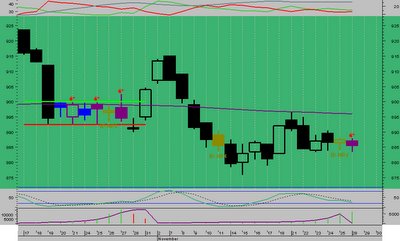
November 29, 2005
1. Today’s Trade Management:
a. Call Apex at 8:45am to check the opening price.
b. Initial Trailing Stop:
i. If the price opens gaps down, close your position immediately. Remember, Oops! is most powerful this time. It is also price-extreme.
ii. If the price opens gapped up, do nothing initially. Close your position after 10:30am if the price stays gapped up.
iii. If the price opens higher, flat or lower, put your buy stop order at 888.5.
c. Possible Exits:
i. MOC
ii. There is a price extreme – a long white candle with close near the high or a long black candle with the close near the low with blow-off volume.
iii. If there is 10-point profit.
iv. Let the trailing buy or sell stop follow the price until it is taken out (if there is a down-trend)
v. Use Fibonacci 161.8% as a target if it is trend-following Oops!
d. Subsequent Trailing Stop:
i. The breakeven point, 885, after the price breaks 879.
2. My actual trade management:
a. I called Apex at 8:46am to check the Opening. The November contract opened lower and the December contract opened flat at 896 and 885.5 respectively. I immediately put my buy stop at 888.5.
b. The price of December contract moved up closer to CI even CI is falling. The December contact is moving down as the crowd buy November contract to cover and sell December contract.
c. I did not monitor until 10am. The price then moved down to 883.5 and stayed at 883.5-884.5 range until 11:45am.
d. The price then moved down to 882.5 at 12pm.
e. I did not monitor as I was with Eric visiting tourist attractions in KL.
f. At 5:10pm, I called to check the price. Foong informed me the current price is 882.5 and 883 with low at 881.5.
g. I will stay with the trade as the price moved below my entry price as ID-NR4 is working.
h. The price moved in tight range and was slow in this roll-over period. It is hard to trade as CI kept moving down but the futures were moving at very slow pace.
3. Trade executed according to plan? Yes
November 30, 2005
1. Today’s Trade Management:
a. Call Apex at 8:45am to check the opening price. Ask them whether I can sell another contract with the account.
b. Initial Trailing Stop:
i. If the price opens gaps down, close your position immediately. Remember, Oops! is most powerful this time. It is also price-extreme.
ii. If the price opens gapped up, do nothing initially. Close your position after 10:30am if the price stays gapped up.
iii. If the price opens higher, flat or lower, put your buy stop order at 888.5.
c. Possible Exits:
i. MOC
ii. There is a price extreme – a long white candle with close near the high or a long black candle with the close near the low with blow-off volume.
iii. If there is 10-point profit.
iv. Let the trailing buy or sell stop follow the price until it is taken out (if there is a down-trend)
v. Use Fibonacci 161.8% as a target at 856 if it is trend-following.
d. Subsequent Trailing Stop:
i. 885, the breakeven point, after the price breaks 879.
ii. 883, after the price breaks recent Next month contract’s low at 876
e. Possible Pyramiding:
i. Put one sell stop at 879, 1 tick below recent Spot month or November contract low at 879.5.
My actual trade management:
a. I called Apex at 8:46am to check the Opening. The November contract opened flat and the December contract opened flat at 897 and 883 respectively. I immediately put my buy stop at 888.5.
b. The price of November contract moved up closer to CI even CI is falling. The December contact is moving down as the crowd buy November contract to cover and sell December contract.
c. The price then moved up for both contracts as CI opened higher and moved higher.
d. The price moved down to 882 for the rest of the morning.
e. The price then fell and broke previous day’s low at 881.5 and hit 880 at 4pm. The price then broke the recent spot month low of 879 to hit low at 878
f. It closed at 879.5 as the CI closed only 2.5 points. CI has lost 7.3 points in a few minutes.
g. It is a tough trade as the price moves within the range of previous day’s range.
h. I did not pyramid as I will wait for my account to be more than RM5000 before doing it.
Trade executed according to plan? Yes
December 1, 2005
Today’s Trade Management:
a. Call Apex at 8:45am to check the opening price. Ask them whether I can sell another contract with the account.
b. Initial Trailing Stop:
i. Since there is a big gap between November and December contract after the expiry of November contract, the price will open gapped-down. In addition, DJIA lost 82.29 points overnight. Therefore, I will not close my position for gap down. I will check whether the price will open gapped-down from December contract. If the price opens gapped down from December contract, place my stop 1 tick above the mid-point of previous day’s bar at 882, not 1 tick below previous day’s bar to avoid whipsaw. 882 is a profitable point.
ii. If the price opens gapped up, do nothing initially. Close your position after 10:30am if the price stays gapped up.
iii. If the price opens higher, flat or lower, put your buy stop order at 888.5.
c. Possible Exits:
i. MOC
ii. There is a price extreme – a long white candle with close near the high or a long black candle with the close near the low.
iii. If there is 10-point profit.
iv. Let the trailing buy or sell stop follow the price until it is taken out (if there is a down-trend)
v. Use Fibonacci 161.8% as a target at 856 if it is trend-following.
d. Subsequent Trailing Stop:
i. 885.5, 1 tick above previous day’s high, if the price stays below 885 after 10:30am.
ii. 885, the breakeven point, after the price breaks 879.
iii. 883, after the price breaks recent Next month contract’s low at 876
My actual trade management:
a. I called Apex at 8:46am to check the Opening. The December contract opened lower at 880. I put my buy stop at 888.5.
b. The price then moved up to 882 and moved down to 879. If I were to pyramid, it is to sell additional contract at 879, 1 tick below recent spot month low of 879.5.
c. The price then stayed at 880.5 and 879 for a while.
d. At 12:30pm, I called to check the price. It broke 878 and hit 876, the next month contract’s low.
e. I lower my stop to 885, my break even point at 12:40pm.
f. The price then broke 876 to hit new low at 872 before closing at 874 as CI closed down 8.5 points.
Trade executed according to plan? Yes
December 2, 2005
Today’s Trade Management:
a. The price may open higher as DJIA gained 106.7 points overnight
b. Call Apex at 8:45am to check the opening price.
c. Initial Trailing Stop:
i. If the price opened gapped down, put a stop at 877.5.
ii. If the price opens gapped up, do nothing initially. Close your position after 10:30am if the price stays gapped up.
iii. If the price opens higher, flat or lower, put your buy stop order at 882.5.
d. Possible Exits:
i. MOC
ii. There is a price extreme – a long white candle with close near the high or a long black candle with the close near the low.
iii. If there is 10-point profit.
iv. Let the trailing buy or sell stop follow the price until it is taken out (if there is a down-trend)
v. Use Fibonacci 161.8% as a target at 856 if it is trend-following.
e. Subsequent Trailing Stop:
i. 880.5, if the price stays below 872 after 10:30am.
ii. 878, the breakeven point, after the price breaks 865.
My actual trade management:
a. I called Apex at 8:46am to check the Opening. The December contract opened higher at 876. I put my buy stop at 882.5, 1 tick above previous day’s high.
b. The price then moved down to 870.5 but moved up to hit high of 878.5 as regional market rebounded.
c. Luckily, I did not lower my stop at 877.5, 1 tick above previous day’s mid-point
d. The price then moved around 875 and 877.5 for the whole after.
e. I did monitor the price at KLSE library from 3:30pm to 5:00pm
f. The price closed at 876 with higher volume. It formed a black hammer.
Trade executed according to plan? Yes
December 5, 2005
Today’s Trade Management:
a. The price may open lower as DJIA lost 35.06 points overnight
b. Call Apex at 8:45am to check the opening price.
c. Initial Trailing Stop:
i. If the price opened gapped down, put a stop at 875, 1 tick above the previous day’s mid-point.
ii. If the price opens gapped up, do nothing initially. Close your position after 10:30am if the price stays gapped up.
iii. If the price opens higher or flat, put your buy stop order at 882.5.
iv. If the price opens lower, put your buy stop order at 879.
d. Possible Exits:
i. MOC
ii. There is a price extreme – a long white candle with close near the high or a long black candle with the close near the low.
iii. If there is 10-point profit.
iv. Let the trailing buy or sell stop follow the price until it is taken out (if there is a down-trend)
v. Use Fibonacci 161.8% as a target at 856 if it is trend-following.
e. Subsequent Trailing Stop:
i. 880.5, if the price stays below 872 after 10:30am.
ii. 878, the breakeven point, after the price breaks 865.
My actual trade management:
a. I called Apex at 8:46am to check the Opening. The December contract opened flat at 876. I put my buy stop at 882.5, 1 tick above 2nd previous day’s high.
b. The price then moved up to 879.5 and fell down to 877. The price then moved up again to 879.5 and fell again. It then broke 879.5 to hit 880.5.
c. It looked like a ascending triangle breakout in intra-day chart.
d. Based on my trade management, I should be out by 879. 879.5 is the previous support level. It is the resistance now. The price may go side-way or up if this level is broken convincingly. Moreover, I should not give up more than 10 points of gain in my trade.
e. I closed my position at 880.5 when the 880 level is broken. I instruct Foong of Apex to close at 880.5 and cancelled my buy stop at 882.5
f. The price felt to 879.5 and broke 880.5 to hit high of 822 resistance level.
g. The price then fell as CI fell after more than 2-point gain
h. The price hit 878 and hit 876.5 before closing at 877.5. There is an evening shooting star after a morning shooting star. The price may go side-way.
Trade executed according to plan? Yes. But I waited for more confirmation.
What I have done best:
a. I follow ID-NR4 trade management.
What I need to improve:
a. I need improve my exit rule so that I can stay consistent.
What I have learned:
a. A hammer with higher volume has high probability of bearish reversal.
